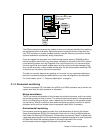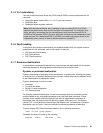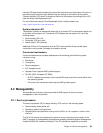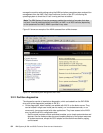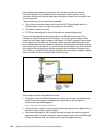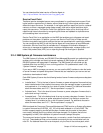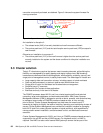Chapter 3. RAS and manageability 87
You can download the latest version of Service Agent at:
ftp://ftp.software.ibm.com/aix/service_agent_code
Service Focal Point
Traditional service strategies become more complicated in a partitioned environment. Each
logical partition reports errors it detects, without determining if other logical partitions also
detect and report the errors. For example, if one logical partition reports an error for a shared
resource, such as a managed system power supply, other active logical partitions might
report the same error. The Service Focal Point application helps you to avoid long lists of
repetitive call-home information by recognizing that these are repeated or duplicate errors
and correlating them into one error.
Service Focal Point is an application on the HMC that enables you to diagnose and repair
problems on the system. In addition, you can use Service Focal Point to initiate service
functions on systems and logical partitions that are not associated with a particular problem.
You can configure the HMC to use the Service Agent call-home feature to send IBM event
information. Service Focal Point is available also in Integrated Virtualization Manager. It
allows you to manage serviceable events, create serviceable events, manage dumps, and
collect vital product data (VPD), but no reporting through Service Agent is possible.
3.2.4 IBM System p5 firmware maintenance
The IBM System p5, pSeries, and RS/6000 Client-Managed Microcode is a methodology that
enables you to manage and install microcode updates on IBM System p5, pSeries, and
RS/6000 systems and associated I/O adapters. The IBM System p5 microcode can be
installed either from an HMC or from a running partition. For update details, see 2.15.6,
“System firmware” on page 70.
If you use an HMC to manage your server, you can use the HMC interface to view the levels
of server firmware and power subsystem firmware that are installed on your server and are
available to download and install.
Each IBM System p5 server has the following levels of server firmware and power subsystem
firmware:
Installed level – This is the level of server firmware or power subsystem firmware that has
been installed and will be installed into memory after the managed system is powered off
and powered on. It is installed on the
t side of system firmware. For additional discussion
about firmware sides, see 2.15.7, “Service processor” on page 73.
Activated level – This is the level of server firmware or power subsystem firmware that is
active and running in memory.
Accepted level – This is the backup level of server or power subsystem firmware. You can
return to this level of server or power subsystem firmware if you decide to remove the
installed level. It is installed on the
p side of system firmware. For additional discussion
about firmware sides, see 2.15.7, “Service processor” on page 73.
IBM introduced the Concurrent Firmware Maintenance (CFM) function on System p5 systems
in system firmware level 01SF230_126_120, which was released on 16 June 2005. This
function supports applying nondisruptive system firmware service packs to the system
concurrently (without requiring a reboot to activate changes). For systems that are not
managed by an HMC, the installation of system firmware is always disruptive.
The concurrent levels of system firmware can, on occasion, contain fixes that are known as
deferred. These deferred fixes can be installed concurrently but are not activated until the
next IPL. For deferred fixes within a service pack, only the fixes in the service pack, which



